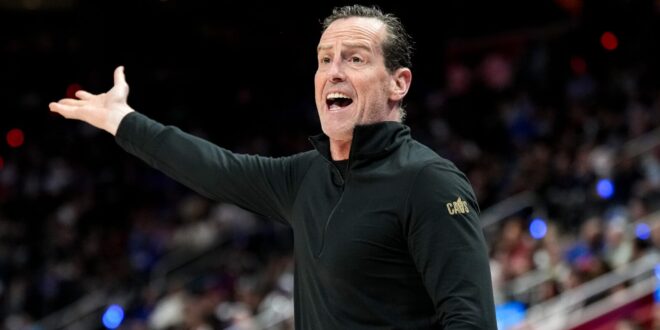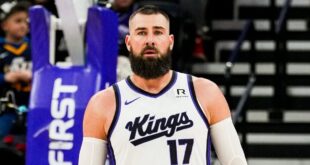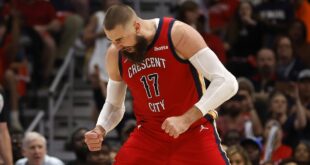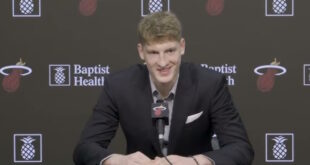The journey of an NBA head coach does not commence with triumph.
It begins the moment the same red carpet that once welcomed you is withdrawn, your security access to the training facility ceases, and the search for your position—one that you devoted your life to achieving—starts.
This journey kicks off when you’re let go.
That’s the moment you discover the strength of your professional network, whether your family is willing to relocate again, and if the 29 other teams noted your contributions while competing against them and might offer support.
It’s also a time for introspection, to assess if you still possess what it takes to thrive in this demanding environment—your intellect, endurance, and mental stability.
Spring signifies a period of transition within the coaching community, and this year has been particularly brutal and unprecedented. The firings have occurred earlier than usual.
Last summer, Mike Brown secured a contract extension with the Sacramento Kings valid through 2026-27, only to be dismissed in December while preparing to board a flight to Los Angeles for the next game. Meanwhile, in March, Taylor Jenkins was unexpectedly let go from a Memphis Grizzlies team actively contending for the playoffs.
Adding to the oddity, Michael Malone was released just three games before the end of the season in Denver, and Mike Budenholzer saw his tenure with the Phoenix Suns cut short after one year into a five-year deal. These coaches, despite having won titles—Bud in 2021, Malone in 2022—found themselves dismissed. Budenholzer succeeded Frank Vogel, who had also lost two jobs in four years following a championship in 2020.
Clearly, the lessons can be harsh and come swiftly. If they resonate, those setbacks can transform into comebacks, propelling you to work harder and smarter at your next opportunity—perhaps eyeing the Coach of the Year accolade?
Enter Kenny Atkinson, the 2024-25 NBA Coach of the Year, who was exactly what the Cleveland Cavaliers needed to secure 64 wins, clinch the top seed in the Eastern Conference, and enhance their chances of winning a title.
“It’s astonishing how moving to a new place can turn out to be the best thing for you,” he remarked.
A New York native, Atkinson’s return as head coach of the Nets ended sooner than he had anticipated.
His aspiration was to establish a long-lasting career with the Brooklyn Nets, but the realities of the NBA often involve brief tenures and sometimes inequitable outcomes.
Initially, it seemed like the ideal match for all the right reasons until it wasn’t. Since he grew up just minutes away in Long Island, this was a homecoming. What could be more rewarding than forging a successful career surrounded by friends and family? A classic New York narrative?
Atkinson paid his dues over eight years as an assistant with the Knicks—where he helped develop Jeremy Lin during the Linsanity era—and the Hawks, which included a 60-win campaign. Throughout this time, he was seen as the rising star among assistants, regularly topping rankings for future job openings, prepared to transition to a head coaching role.
However, here’s the twist: these initial head coach openings are typically available at teams that require significant rebuilding. Enter the Nets, who approached him in 2016. He took over the league’s worst team, with minimal talent and scarce draft assets. Unsurprisingly, they finished his first season with a 20-62 record, only marginally improving by eight wins the next year.
Then came the breakthrough in their rebuilding phase: Brooklyn made the playoffs in Year Three. This progress reflected positively on Atkinson, as he had effectively developed young talent, leading the Nets to trade some of those players to expedite the rebuild. Suddenly, in 2019-20, Atkinson found himself with superstars Kevin Durant and Kyrie Irving, both seasoned champions.
Unexpectedly, he did not finish the season, departing by “mutual agreement”—a euphemism for being fired—with 20 games remaining, leaving many puzzled.
While the Nets were 28-34 at that point, Atkinson had never coached Durant, who was recovering from an Achilles injury, and had received only 20 games from Irving before he underwent shoulder surgery. Following a team meeting, the front office began to doubt whether their star players supported Atkinson, leading to their unease.
“That one stung,” Atkinson confided. “It hurt me, it hurt my family; we were settling into Brooklyn. I had to explain to my kids that I’d been let go. It’s not merely personal; it’s also about competition and pride. As a local, I believe that if I were in another city, it wouldn’t have hit as hard, but with New York, it felt magnified. I wanted to remain there longer.”
The takeaway: This is a league dominated by superstars. They wield significant power over their teams. Some players are secure; others are not. All come with considerable egos, and it’s the coach’s job to connect, communicate, and sometimes accommodate.
Atkinson is naturally friendly, albeit with high expectations for himself and his team. Growing up in a family of eight boys, sleeping in bunk beds, taught him to be competitive and assertive. Coupled with a touch of New York grit, it’s conceivable that his style did not gel with every player.
He distanced himself from Brooklyn by joining the Clippers, working alongside Ty Lue for a reset, which lasted a season.
Then the call came from Steve Kerr, who invited Atkinson to join the Warriors’ bench. Having a voice next to Stephen Curry, Draymond Green, and Klay Thompson was an opportunity too good to pass up. This wasn’t merely a step down.
Rather, it was a chance for rejuvenation before pursuing his next opportunity. Over three seasons with the Warriors—one of which earned him a championship ring—Atkinson took the time to observe and absorb.
“I paid attention to Steve’s communication style, how he engages with star players, and I learned a great deal from both Draymond and Steph, watching their interactions,” he explained. “I witnessed how they responded during a Finals downturn against the Celtics when down 2-0.
“I was observing and I emerged feeling much more confident afterward. I got to experience the conference finals with Ty and a championship with Steve. It’s funny how life unfolds.”
His time with the Warriors was rewarding enough for Atkinson to turn down a position with the Hornets, as he wanted to spare his family yet another rapid relocation.
A few years later, the circumstances aligned perfectly for him to accept the Cavaliers’ position last summer.
Kenny Atkinson guided the Cavaliers to the top seed in the Eastern Conference.
Both the coach and the team were mutually beneficial. Atkinson wasn’t stepping into a rebuilding scenario like he had with the Nets. The Cavaliers already boasted a star in Donovan Mitchell and a solid supporting cast; however, they had underperformed in the playoffs for two consecutive years, winning only one series. Atkinson brought experience and newfound wisdom.
“I’ve definitely changed,” he remarked. “I wouldn’t have been ready for this role before. I needed to be let go, go through those experiences, and learn.
“Now, I feel incredibly confident in my abilities, unlike before.”
The foremost challenge for Atkinson was building a relationship of trust with Mitchell and Darius Garland. He also harmonized the play of the two guards, paving the way for the Cavaliers to succeed. Evan Mobley transformed into a defensive stalwart this season, and Ty Jerome developed unexpectedly into a reliable bench contributor.
The Cavaliers’ offense emphasizes motion and versatility; when Mitchell has an off night, others are prepared to step up. Everybody benefits.
The feedback regarding Atkinson is overwhelmingly positive.
Mitchell, who endorsed Atkinson’s hiring, said, “He implemented a system that everyone embraced. You can see the confidence in this locker room, and he helped cultivate that.”
Garland echoed: “Players feel they can contribute each night; everyone has a role, and hard work is acknowledged. It doesn’t matter who you are.”
Atkinson arrived as the Cavaliers were positioned to win, yet such scenarios can also pose challenges. Budenholzer can attest to that after a difficult season with three star players in Phoenix.
“The timing is crucial for me to elevate this team in their progression, coming from my experiences with Ty and Steve. I gained insights into working with superstar players and coaching elite teams,” he noted. “Back with Brooklyn, I was a novice with a young roster trying to rebuild. Now, I’m fortunate to coach a contending team. It’s about being in the right place at the right time.”
Atkinson is fully aware of the precarious coaching climate, having witnessed the whirlwind of dismissals around him this season. Drawing from his own experiences, he provides perspective on such firings.
“You become somewhat desensitized to it,” he observed. “I can’t say I’m shocked. Having been around the league, I understand that many elements must align—ownership, the front office, and coaching. There are numerous moving parts, and if they fall out of sync, it becomes fragile.
However, there are only 30 such jobs globally, they come with lucrative compensation, and everyone experiences the same fate eventually.
“We all accepted this reality,” he laughed, “and I’ll be ready when it comes around again.”
Former Trail Blazers coach Terry Stotts has stepped in as an assistant on the Warriors’ bench, replacing Atkinson.
The landscape of NBA coaching is ever-changing, continuously adapting. For someone to land a job, another must vacate that position. The misfortune of one coach often leads to the fortune of another.
What transpires after a coach is let go? Each journey is unique. Some find new opportunities, while others remain as assistants, and some wait for the phone to ring.
Here’s a look at head coaches and the paths they took after one door closed:
What happened: Doc Rivers is well familiar with the coaching carousel, having moved between several teams. A former NBA champion and Coach of the Year, he was let go by the Magic, Celtics, Clippers and 76ers. With only brief TV stints in between those roles, he quickly found new positions and is currently coaching the Bucks.
The aftermath: When asked if he ever senses the end approaching in those situations, Rivers responds without hesitation:
“In nearly every case, you have a sense beforehand.”
Typically, the message comes from the general manager, but in the Clippers’ case, it was team owner Steve Ballmer.
“I genuinely appreciated that,” Rivers said, reflecting on the situation. “That’s how it should be done—with the owner, the person who employed you. Steve and I had extensive discussions about my job security. I can’t tell if he fired me or if I fired myself, as I didn’t feel he was fully committed to keeping me.”
Rivers recognized the dire signs with the Clippers in 2020.
“We surrendered a 3-1 lead in the bubble. Then I read reports later indicating some players wanted to leave. They were no longer invested. That’s what cost me my position.
“However, when Steve took over the team in 2014, I was already on board. I never truly felt like I was his top choice. I told him, ‘If you want to hire someone else, don’t hesitate.’”
After parting ways with the Clippers, Rivers received three job offers the very next day—he chose the position with the Sixers. In turn, the Clippers hired Ty Lue, the coach he had mentored.
What happened: Terry Stotts ranks second in coaching wins in Trail Blazers history and spent nine years in Portland—an extended stay for any coach. He led the team to the playoffs every year but one, guided them to a conference finals, and ran the franchise during Damian Lillard’s peak years.
The aftermath: Stotts is now an assistant coach with the Warriors, a role that benefits both him and the team. Steve Kerr has consistently valued having former head coaches on staff—Stotts joins the ranks of Mike Brown, Kenny Atkinson, and Alvin Gentry, among others.
Should Stotts receive no further opportunities as a head coach, he appears content. At 67, he has financial security and still enjoys coaching.
“Getting fired was bittersweet because of our relative success in Portland,” he said. “It wasn’t a sudden shock to me, as I had three contracts in my final year there.
“I pursued opportunities with Indiana next, but Rick Carlisle was chosen. At my age, I felt no urgency to rush. Factors like a coach’s status, available options, and financial stability determine the next career steps. After my dismissal in Atlanta, I was young and motivated to work again. After Portland, my outlook shifted, allowing me to be more selective.”
Having no children and the luxury of financial security gave Stotts the freedom to accept a role with Kerr. It was an ideal fit.
“He empowers all of us to contribute our insights,” he stated. “He effectively manages the staff. He knows how to involve everyone, yet he’s discerning about which direction to take. He genuinely respects my basketball opinions. At times, I’d think, ‘He’s not implementing my suggestions,’ but I understand that, as the head coach, he has to make the final call.”
What happened: Dave Joerger embodies the essence of a coaching grinder, having honed his skills through years in minor leagues (winning five championships), as head coach for the Memphis Grizzlies and Sacramento Kings, and as an assistant with four NBA teams. He was let go by the Kings in 2019 after a three-year tenure.
The aftermath: He currently serves as an assistant coach for the Bucks after previously working alongside Rivers with the Sixers. Joerger holds a strong connection to the Grizzlies, where he began as an assistant and subsequently led the team without a single losing season, reaching the playoffs every year.
He was aware of the volatile nature of coaching jobs, which helped him avoid becoming too complacent.
“We resided in Memphis near a military base,” he explained. “The military families understood the coaching lifestyle, so I often expressed that I might only be around for two years, three at most, before moving to the next opportunity. We bonded over that shared experience.
“Relocating can take a toll on children and relationships. Some coaches choose a home base where their family remains while they work with another team. It’s a common scenario.”
Once a coaching position ends, the networking starts. Joerger has a solid reputation within the coaching community, and recommendations often play an instrumental role.
“Sometimes you have to wait it out, other times you find the next opportunity quickly,” he stated. “A head coach might recommend you to another through their network, saying, ‘This person will really benefit your team.’
“There are positives in this business, but it can be harsh and emotionally taxing. You must prepare yourself as best as you can for these realities.”
* * *
Shaun Powell has covered the NBA for over 25 years. You can reach him via email, find his archive here, and follow him on social media.
The opinions expressed in this article do not necessarily reflect those of the NBA, its teams, or Warner Bros. Discovery.
 NBA News NBA News, Match Reports and Updates
NBA News NBA News, Match Reports and Updates



